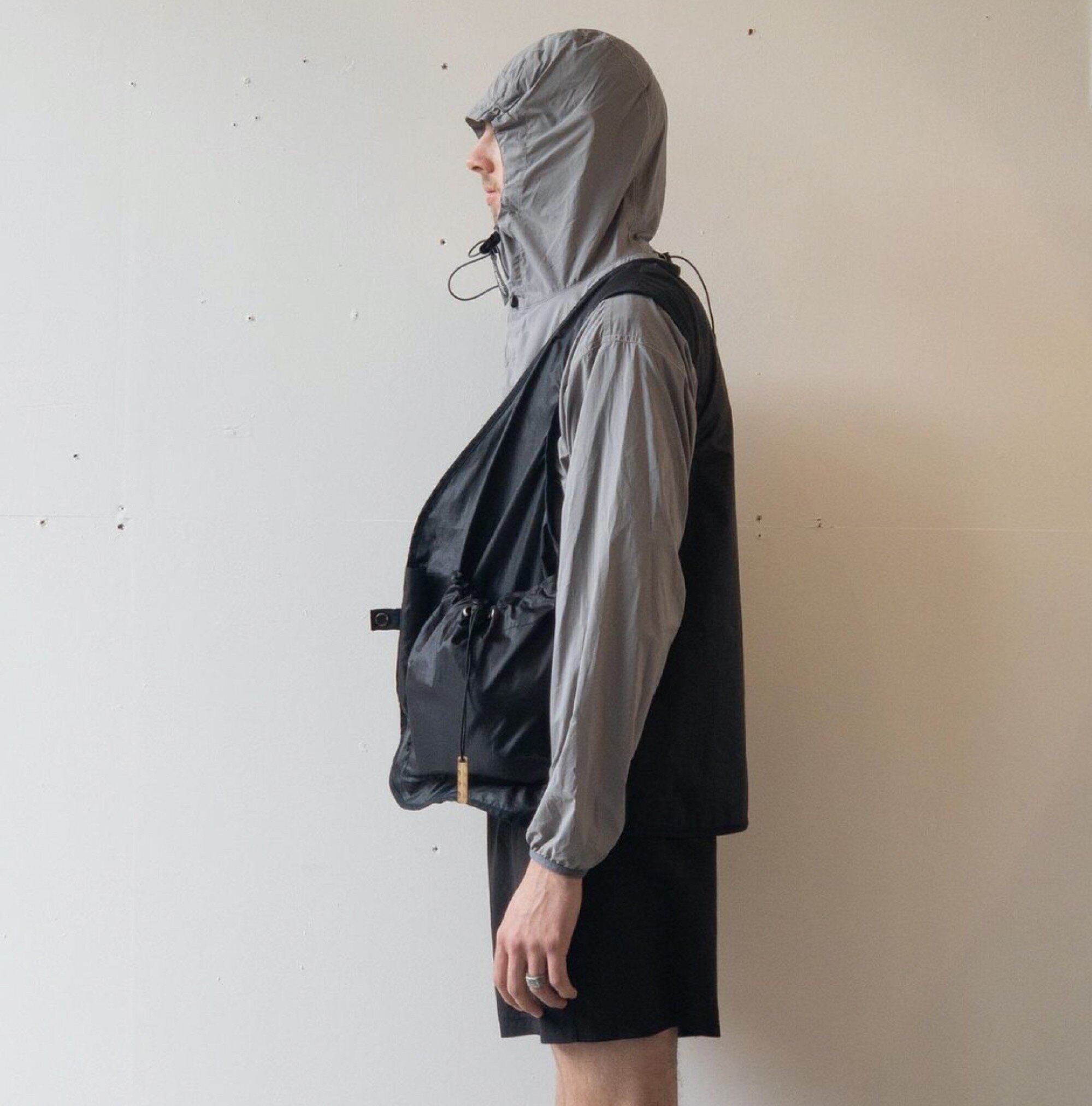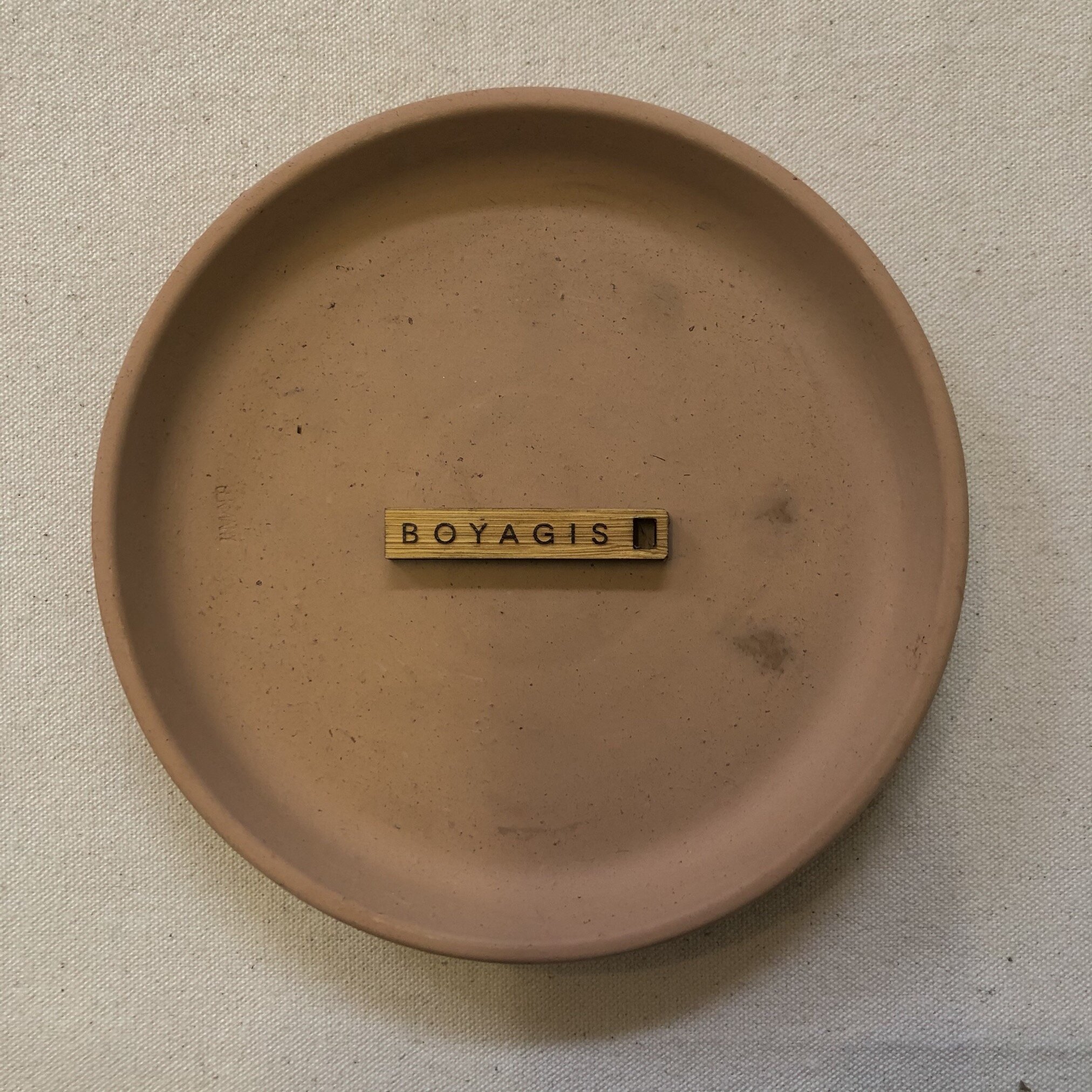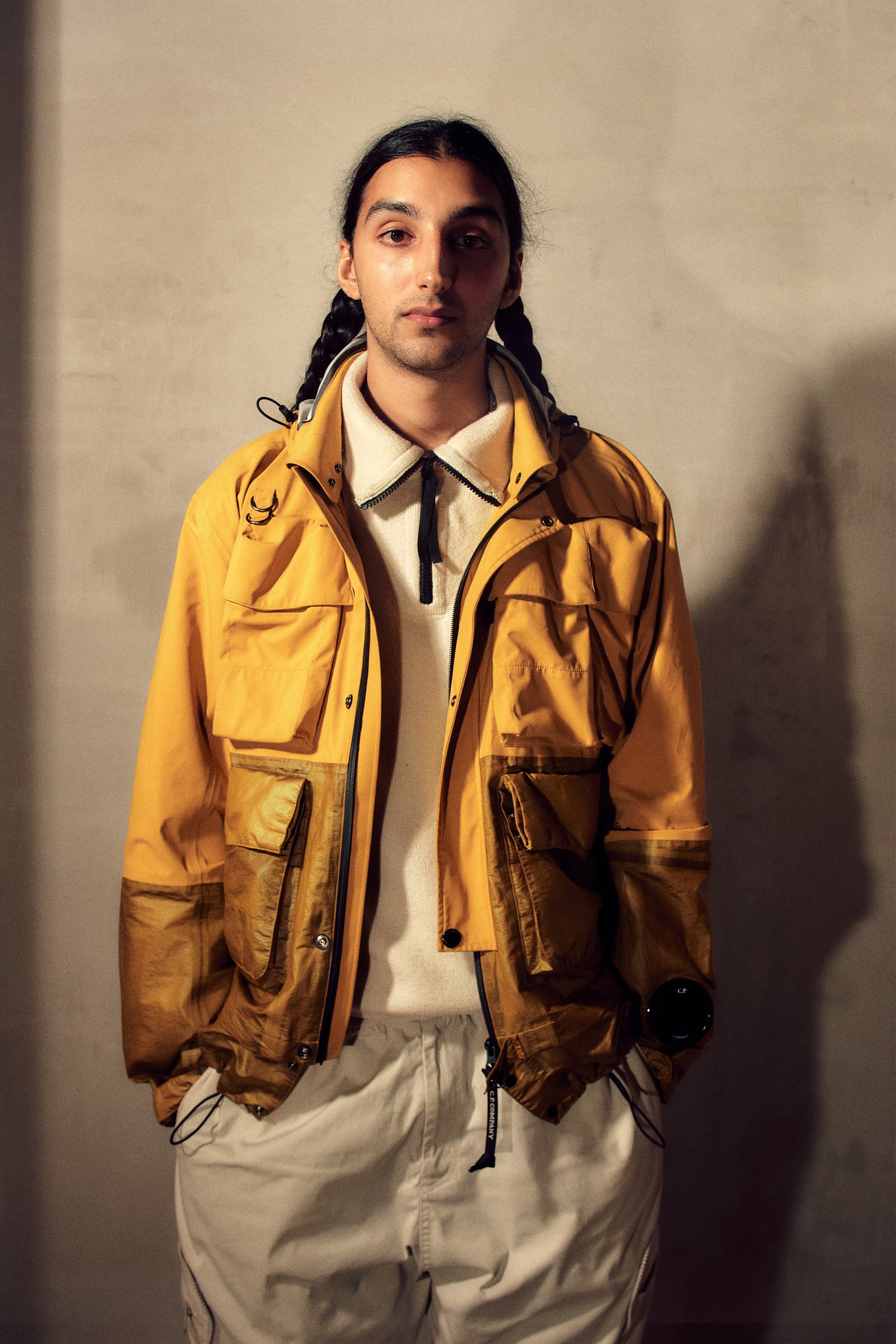BOYAGIS - INCORPORATING SUSTAINABILITY INTO DESIGN AND FUNCTIONAL FABRICS

Throughout recent history, the UK has been a hotspot for creative talent, whether we’re talking about fashion, design, music, architecture - the list goes on.
But, as individuals who follow fashion fairly closely, the UK is brimming with young talent, some of which we’ve interviewed in the past and others we’re in touch with on a regular basis - Rob Boyd, Robert Newman, to name a couple. One of these individuals is Louis Williams. At the age of 19, Louis is not being held down by his current habituation in Rye - a coastal town in East Sussex - and is relentlessly pursuing his desire to create and design clothing that looks to familiar areas of our lives for inspiration. Crafting goods under his namesake label, Boyagis, Williams’ holds sustainability at the core of his practices as he strives to source leftover fabrics or incorporate uncommon natural materials like bamboo.
For Sabukaru, Ali George Hinkins sent over some questions to Louis so we could learn a bit more about him and his work. We touched on the creative process of designing a garment, doing said product justice through its presentation and what he recommends to getting started making things!
Hey Louis. Please could you introduce yourself and tell us about what you do?
My name is Louis Williams, I’m 19 and I live in a coastal town called Rye, located in East Sussex, UK. It’s a lovely area if you appreciate being surrounded by the outdoors. For me, it’s perfect as I get most of my inspiration for Boyagis from what’s in my surrounding area, whether it’s from a tree line or a crack in a pavement. I’ve been lucky enough to have grown up surrounded by the British countryside so I suppose it’s where I'd gain most of my inspiration from. As I am both the designer and owner of Boyagis, everything I have created so far has been made independently by myself in my studio in St. Leonard’s, UK. I started the brand about a year and a half ago, it’s really been the main focus since the first ideas of creating Boyagis arose.
At a young age, I was always feeling different fabrics, whether it was the GORE-TEX on a skiing jacket or an aged sail cloth. I think being interested in exploring the use and aesthetic of different materials has had a massive impact on the way I design.
How did you begin this journey yourself?
I’ve always had a love for clothing and different kinds of fabrics. While growing up, we had a house in the Outer Hebrides - a small island chain located off the west coast of Scotland - and we skied most years and from that you really learn to appreciate the outdoors and with that comes a need for a ‘uniform’. That uniform is a piece of clothing that certainly demands fabrics that are both functional and able to withstand the given conditions. The aim I have for Boyagis is to merge day to day clothing with functional elements inspired by my love for outdoor wear.
At a young age, I was always feeling different fabrics, whether it was the GORE-TEX on a skiing jacket or an aged sail cloth. I think being interested in exploring the use and aesthetic of different materials has had a massive impact on the way I design. I do sometimes think about why I am starting a clothing brand and, to be completely honest, I couldn’t answer that. I mean, it feels natural to be working with fabrics and designing clothing, it helps having a deeper love for clothing and also for design.
Who/what inspires you to do what you do?
That’s a difficult question because I could go on for a very long time describing everything and everyone that inspires me. I’ll mention a few things that I’ve briefly described in some of your earlier questions. First of all, I’m really inspired by my environment, that really could be any environment whether it’s from going on a walk in a woodland or through central London. The way that I work is that I see shapes and reinterpret them in a different context.
For example, I’ll look at a chair design from the likes of Charles & Ray Eames or even a window on a building that I walk past and see it as the shape of a pocket, I take this shape and put it onto my designs and work from there. I’m inspired by quite a few designers/brands/books such as: Story mfg, Arnar Mar Jonsson, Maharishi, The Supermodern Wardrobe, The Encyclopaedia of Camouflage, the list goes on...
The joy with Instagram and other social media platforms is that there are so many amazing accounts showcasing outerwear, technical clothing and modern clothing alongside many design accounts/furniture accounts. It’s a simple and very efficient way to create mood boards and as we all know they are extremely accessible making them a great resource for quick inspiration.
What projects do you currently have in the works that are set to be announced soon?
So, at the moment and for about the last year and a half I’ve been working on my clothing brand ‘Boyagis’. I think it's important as a young designer to really focus on creating a company that has sustainability at the core of every step, from the designing of products to how they are made; that is really one of the main focuses with Boyagis.
I’ve spent a lot of time developing different ways of branding Boyagis, I mean you’ll see on Instagram about the use of bamboo. I think bamboo as a material has really been overlooked within the fashion industry to create products that can replace plastic. Bamboo is very sustainable as it grows extremely quickly and does everything you want it to do - it’s strong, water resistant and is natural!! That’s why I’ve spent a lot of time developing and sampling with bamboo to create branded chord pulls and other things that are currently in the works as we speak.
Another main focus with Boyagis is the use of end of line fabrics. There are a lot of beautiful fabrics not being used by larger companies/design houses due to minor defects. I’ll snap up those materials as most of the time they are still completely usable, as long as it doesn’t change the durability or quality of the fabric. Through doing this I’m creating less waste because I’m using waste.
So, at the moment, I’m really working in my studio most days drawing/sampling garments I’ve designed, changing older designs and thinking very hard about what pieces I want to progress with and have made ready for the release of my first capsule collection 001 for Boyagis. It’s not cheap getting garments made so it does make you think about what pieces you want to fully move forward with to production.
To cut a long story short, I’m planning to release Boyagis with made to order pieces in 2021, the date is yet to be announced. It’s going to be around an 8/10 piece collection including accessories and other potential collaborations that are being talked about.
What kind of design cues do you take when conceptualising an idea? Do you look at vintage functional outdoors clothing or military-garb? These are just two sources I picked out from your designs.
You are pretty spot on when saying I’m influenced by military uniform and functional clothing. I’ve always been really inspired by the focus on pure functionality when it comes to how military clothing is designed. I am particularly intrigued by the many different development phases military uniforms require when being designed. This critically important stage of refinement is what inspires me.
A lot of concepts and ideas for my designs come from my own evaluation of what I expect from a garment. For example, the ‘Smock Jacket’ I’ve designed, which is currently in a sample phase seen on the ‘Boyagis’ Instagram. It’s my take on a fisherman’s smock, I look at a garment and with an idea in my head, start to sketch and conceptualise what I’d like. It’s things that we face in day to day situations that I incorporate within my design process.
The clothing I make is what some would describe as “day to day” clothing but when put up against something that needs technical/functional design will stand up to the test.
As a designer yourself, why is it important to incorporate functional details and fabrics into your pieces?
For me personally, I suppose it may come naturally as I’ve always worn clothing that would fit under a bracket of ‘functional’, it’s something that I’ve definitely seen change in the fashion world within the last few years. Designers and brands are more directed towards the aesthetic of functional clothing, I feel It’s understandable to why this has happened, maybe because people have really started to look more towards quality and usability more than just the label of the clothing. During the COVID 19 pandemic, people have started to appreciate the outdoors more, this only means the clothing choices have changed due to needing clothing for specific needs. For me, there’s nothing better than having a piece of clothing with a drawstring that changes the shape of the garment, or even a pocket that’s hidden, it’s an element of surprise that I’ve tried to embody within my design.
In the UK, we have an emerging scene of young creative designers who are pushing the envelope when it comes to technical clothing, where do you see yourself in this current landscape?
I’d say Boyagis falls within the region of functional/technical clothing and also every day to day wear, designed for both a rural and urban environment. For me it’s all about the quality of the clothing and that’s really what I’m trying to create with Boyagis. I’m really focusing on the smaller details whether it’s from the cord pulls to the labels - always with a sustainable outlook in mind.
In the past, I've spoken to designers from the UK, such as Rob Boyd and Robert Newman, who place emphasis on performance and functionality. Do you think this is inherent to the current generation of designers, especially in the UK, and why?
Yes, I do agree with this as I’ve seen a definite change with current designers on the scene. This may be because many of the leading brands, such as Prada, Stone island and others, have started to really embody functional design, these are the brands who are setting the trends so other designers follow.
Once you have brought an idea to life, how important is it to present that end product in a way that does the whole process justice?
For me, it’s very important to present a garment in a way that does the whole process justice, as a lot of the time the end result is all people may see. Throughout my years of being in art college and designing, I’ve always been pretty bad at displaying my process. The reason for this is that I get very sucked into what I’m designing/making, so for most of the time I forget to record the process. With Boyagis, annoyingly, it’s the case 100% of the time so having a shoot that showcases the garment in a way that I’m happy with is very important. When I’m stylising a shoot, I think about what I’d wear the garment with and what I’ll wear with it to create a nice silhouette for shoot purpose. Through doing this, you create an aesthetic that carries the design.
This might seem like an obvious question but I think it's important for younger people or those who are looking into making their own apparel and accessories; what do you need to get started? In terms of equipment etc.
I like this question because I feel like if I were to read an answer to this it would’ve massively helped me. There are a few things that you really could look into getting and trying to find - such as a sewing machine, it doesn’t necessarily have to be an industrial machine but if you want to spend the extra and also if you have the space it makes a difference.
I remember growing up using my mum's machine, so if you have a machine in your household I’d highly recommend just sitting behind it and getting to grips with some different techniques - it all helps in the long run. Other things that maybe a lot of people overlook is to invest in an archive! This doesn’t have to be an archive of stamps or Raf Simons pieces but just pieces that catch your eye, it could be anything from furniture to vintage military clothing. It’s really just things you can reference and take inspiration from. You don't necessarily need to spend vast amounts of money building it up; it's more something you do over time and then really appreciate.
One more thing to look into would be getting some fashion books, this is a very nice way of starting to learn about fashion. Some very amazing books that have changed the way I design and think about fashion are - The Supermodern Wardrobe by Andrew Bolton, Techno Textiles by Sarah E.Braddock and Marie O’mahony, Disruptive Pattern Material: An Encyclopaedia Of Camouflage by Hardy Biechman. There are many different books about design and fashion, they are all out there, it's just finding them.
With the future in mind, do you have your sights set on working in this industry or are you keeping this as a side project for now?
I mean this really is the main focus! I love designing and I can see myself doing it for the foreseeable future. I’m very excited to work further with Boyagis and make it something that really expresses me as a designer and also as a creative. I’m very looking forward to future collaborations and also for the journey that comes with creating a brand. It’s all very new to
me so there is a lot still to know and learn about the industry, furthermore I want to push the ideas and the aesthetic that I am creating with Boyagis.
I’m very open to looking at working with other creatives to share my ideas and also my vision. So I suppose it’s the industry that I can see myself nestling into, how this happens I’m unsure, but that’s the exciting part.
Thank you for your time!
About the author:
Ali George Hinkins is a UK-based freelance writer, currently contributing to eye_C Mag, Sabukaru Online and his own respective website. The topics he covers are broad but he mostly dabbles in technical clothing, from performance-wear to outdoors gear. Striving to provide content outside of generic media output, he immerses himself in the realities of those working inside the industry and translates those stories.


















